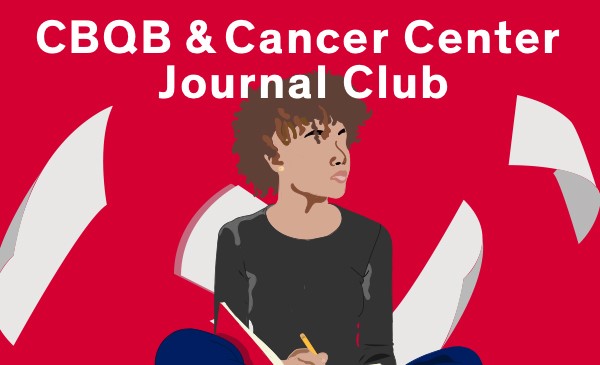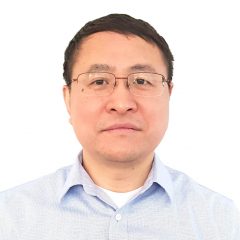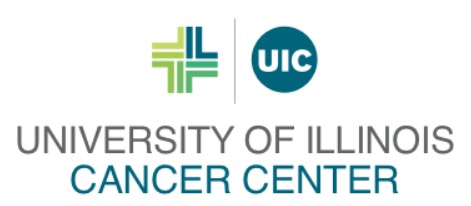Journal Club
Journal Club intro text

The Journal Club Of the Center for Bioinformatics and Quantitative Biology and UI Cancer Center
The CBQB-UI Cancer Center Journal Club will be mentored by faculty members. Graduate students and trainees will lead discussions on highly impactful papers of bioinformatics and quantitative modeling as well as papers of experimental studies that provide opportunity of modeling.
The journal club serves for multiple objectives including but not limited to
- keeping up-to-date with recently published literature
- improving critique skills and communication skills
- fostering interactions.
The Journal Club is offered in partnership with the University of Illinois Cancer Center
Upcoming journal presentations
event dates, presenters, and titles
| Date | Presenter | Topic |
|---|---|---|
| 04/21/2025 | Aureo Zanon (Advisor: Dr. Xiaowei Wang) | Multiscale topology classifies cells in subcellular spatial transcriptomics [view related article] |
| 04/07/2025 | Andi Rosner (Advisor: Dr. Kevin Drew) | Predictomes, a classifier-curated database of AlphaFold-modeled protein-protein interactions [view related article] |
| 03/03/2025 | Jeff Kim (Advisor: Dr. Yang Dai) | Deciphering cell–cell communication at single-cell resolution for spatial transcriptomics with subgraph-based graph attention network [view related article] |
| 02/03/2025 | Blake Williams (Advisor: Dr. Beatriz Peñalver Bernabé) | High-resolution alignment of single-cell and spatial transcriptomes with CytoSPACE [view related article] |
Journal Club
Guide for Paper Selection
Guide for paper selection
- Decide the journal club papers by consulting with your advisor(s) or faculty mentors weeks prior to the presentation date. Papers from high-impact journals are preferred.
- Topics/areas suggested but not limited
- biotechnology methods,
- quantitative/statistical methods,
- system biology,
- gene regulation, and
- omics
Guide for Article Critiquing
Topic Archive
2024
11/25/2024 – Tina Khajeh (Advisor: Yang Dai) – TMO-Net: An Explainable Pretrained Multi-Omics Model for Multi-Task Learning in Oncology [view related article]
11/4/2024 – Timur Rusanov (Advisor: Ameen Salahudeen) – CellCharter reveals spatial cell niches associated with tissue remodeling and cell plasticity [view related article]
10/14/2024 – Mary Menhart (Advisor: Constantinos Chronis) – Scaling cross-tissue single-cell annotation models [view related article]
9/30/2024 – Pourya Delafrouz (Advisor: Jie Liang) Evaluating the role of the nuclear microenvironment in gene function by population-based modeling [view related article]
4/22/2024 – Akshaya Rajaraman (Advisor: Kevin Drew) – Evaluation of large language models for discovery of gene set function [view related article]
4/1/2024 – Bowei Ye (Advisor: Jie Liang) – A sequence-based global map of regulatory activity for deciphering human genetics [view related article]
3/4/2024 – Minsu Cho (Advisor: Xiaowei Wang) – A new Bayesian factor analysis method improves detection of genes and biological processes affected by perturbations in single-cell CRISPR screening [view related article]
2/5/2024 – Brandon Lukas (Advisor: Yang Dai) – CREaTor: zero-shot cis-regulatory pattern modeling with attention mechanisms [view related article]
2023
11/20/2023 – Sam Fischer (Advisor: Kevin Drew) – Structure prediction of protein-ligand complexes from sequence information with Umol [view related article]
10/30/2023 – Lin Du (advisor: Liang) – Simultaneous Profiling of Chromatin Architecture and Transcription in Single Cells [view related article]
10/16/2023 – Julianne Jorgensen (advisor: Layden Lab/Dai Lab) – Predicting metabolomic profiles from microbial composition through neural ordinary differential equations. [view related article]
8/28/2023 – Mark Sanborn (advisor: Rehman) – Genome-wide prediction of disease variant effects with a deep protein language model, which was published yesterday. [view related article]
4/24/2023 – Xinge Wang – Single-cell eQTL mapping identifies cell type–specific genetic control of autoimmune disease. [view related article]
3/27/2023 – Hammad Farooq – Cell-type-specific prediction of 3D chromatin organization enables high-throughput in silico genetic screening. [view related article]
3/6/2023 – Ken Tsui – The transition state and regulation of γ-TuRC-mediated microtubule nucleation revealed by single molecule microscopy[view related article]
1/30/2023 – Gongyu Tang – UFold: fast and accurate RNA secondary structure prediction with deep learning [view related article]
2022
11/28/2022 – Mehrdad Zandigohar – A deep generative model for multi-view profiling of single-cell RNA-seq and ATAC-seq data [view related article]
10/31/2022 – Aydolun Petenkaya – SCENIC+: single-cell multiomic inference of enhancers and gene regulatory networks [view related article]
10/03/2022 – Emma Lee – Integration of machine learning and genome-scale metabolic modeling identifies multi-omics biomarkers for radiation resistance [view related article]
9/19/2022 – Nima Mostafazadeh – Nonlinear mechanics of lamin filaments and the meshwork topology build an emergent nuclear lamina [view related article]
4/4/2022 – Boshen Wang (Liang Lab) – Predicting protein function domains [view related article]
3/7/2022 – Giuseppe Lauricella & Moein Naderi (Peng lab) – Continuous Inertial Focusing and Separation of Particles by Shape [view related article]
2/7/2022 – Shang Gao (Yang/Rehman Lab) – Mapping single-cell data to reference atlases by transfer learning [view related article]
1/24/2022 – Suzanne Amelia Alvernaz (Penalver-Bernabe Lab) – Context-aware dimensionality reduction deconvolutes gut microbial community dynamics [view related article]
2021
11/15/2021 – Xinyi Liu (Wang lab) – Integrating microarray-based spatial transcriptomics and single-cell RNA-seq reveals tissue architecture in pancreatic ductal adenocarcinomas [view related article]
11/01/2021 – Aydolun Petenkaya (Liang/Chronis lab) – Chromatin Velocity reveals epigenetic dynamics by single-cell profiling of heterochromatin and euchromatin [view related article]
10/18/2021 – Yongchao Huang (Dai/Penalver-Bernabe Lab) – Integration of multiomics data with graph convolutional networks to identify new cancer genes and their associated molecular mechanisms [view related article]
10/4/2021 – Yiyu Pang (Liang lab) – Generalizing RNA velocity to transient cell states through dynamical modeling [view related article]
Mentors

Our goal with this is to promote the active dissemination of knowledge on novel methodological advances, facilitate discussion on fundamental aspects of gene and nuclear regulation, and increase awareness on systems biology approaches.

We hope the journal club will help trainees improve critical literature appraisal skills in identifying knowledge gaps and future research questions, and develop communication competency at the same time.

I think this would be a terrific opportunity for the trainees to get familiar with new research topics, and at the same time develop critical thinking skills.
Partnership
